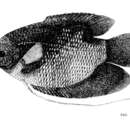Diagnostic Description
provided by Fishbase
Differs from the other three known species of Osphronemus in having oral teeth increasingly enlarged and externalized in large adults, a condition apparently unique within anabantoid fishes. In large specimens examined, over 40 cm SL, all of the jaw teeth are enlarged, especially those in the outermost rows, which lie on the external surface of the jaws entirely outside the mouth when it is shut. Coloration of juveniles and adults also is diagnostic. Small juveniles have 6 or 7 vertical bars and a supra-anal dark oval spot, none of which are retained by adults and subadults. Juveniles over about 10 cm have a reddish orangish stripe on the lower part of the head and breast, a feature not observed in any other species. All adults have extensive dark (almost black) areas ventrally and pale areas dorsally. Several large specimens (especially from Stung Treng market, Cambodia) with large and irregular red blotches that superficially at least look very muck like bodied bruises.
Life Cycle
provided by Fishbase
Builds a small nest, made of leaves and roots of a plant named "gohk kai" in Takam, just below the Lee Pee Waterfalls in southern Laos. Eggs and young are guarded by one parent as observed in the Mekong basin at Stung Treng.
Migration
provided by Fishbase
Potamodromous. Migrating within streams, migratory in rivers, e.g. Saliminus, Moxostoma, Labeo. Migrations should be cyclical and predictable and cover more than 100 km.
Morphology
provided by Fishbase
Dorsal spines (total): 14 - 16; Dorsal soft rays (total): 10 - 11; Anal spines: 11 - 13; Analsoft rays: 17 - 19
Biology
provided by Fishbase
Occurs in pools of large rivers and in flooded forests during the rainy season. Feeds mainly on plant matter including fruits, leaves, and flowers, with some insects and crustaceans. Known to reproduce in non-flowing waters near the river shore during lowest water levels (Ref. 12693). Undertakes lateral migrations from the Mekong mainstream into floodplain areas during the flood season and returns to the Mekong River or other permanent water bodies during the dry season (Ref. 37770). These movements are triggered when water levels change (Ref. 37770). Marketed fresh (Ref. 12693).
Importance
provided by Fishbase
fisheries: commercial
Elephant ear gourami
provided by wikipedia EN
The elephant ear gourami (Osphronemus exodon) is a large species of gourami native to the Mekong in Thailand, Laos, and Cambodia.
Distribution and habitat
In the wild, the elephant ear gourami is found in the Mekong river basin of Thailand, Laos, and Cambodia.[2] It is only known for certain from the middle part of the basin, from Kampong Cham Province (central Cambodia) to Sainyabuli Province (northern Laos).[3] The closely related giant gourami (O. goramy) has been reported from the same section, but these records are likely misidentifications of elephant ear gouramis.[4][5] In contrast, reports of elephant ear gouramis from the Mekong Delta are possibly misidentifications of giant gouramis.[3] The only section of the Mekong basin where the giant gourami likely occurs naturally are in the southernmost part, like tributaries originating in the northern Cardamom Mountains.[4][5]
During the wet season, elephant ear gouramis are found in flooded forests and floodplains. During the dry season, they are found in permanent bodies of water, like the Mekong mainstream.[2] Their seasonal movements are triggered by water levels.[3]
Description
Adults can grow up to 60 centimetres (24 in). Like other species of the genus Osphronemus, juveniles and adults of this species have physical differences. Juveniles have 6 or 7 vertical stripes and a spot on the back, which fades as they get older. A red orange stripe appears around the bottom of the head when a juvenile grows up to about around 10 centimetres (3.9 in). Adults are pale on its fins and blackish on its body.
Conservation
Elephant ear gouramis are listed as vulnerable by the IUCN.[1] Dams in the Mekong disrupted the wet and dry season cycle which lowered the population of this species.
Reproduction
Adults reproduce in non flowing waters. They build nests with leaves and roots then one parent guards the nest.
References
-
^ a b Jenkins, A.; Kullander, F.F.; Tan, H.H. (2009). "Osphronemus exodon". IUCN Red List of Threatened Species. 2009: e.T169508A6640069. doi:10.2305/IUCN.UK.2009-2.RLTS.T169508A6640069.en. Retrieved 20 November 2021.
-
^ a b Froese, Rainer; Pauly, Daniel (eds.) (2015). "Osphronemus exodon" in FishBase. March 2015 version.
-
^ a b c Poulsen, A.F., and Valbo-Jørgensen, J. (2000). Fish Migrations and Spawning Habits in the Mekong Mainstream - A Survey using Local Knowledge. AMFC Technical Report. Mekong River Commission, Phnom Penh, Cambodia.
-
^ a b Rainboth, W.J. (1996). Fishes of the Cambodian Mekong, p. 218. FAO, United Nations. ISBN 92-5-103743-4.
-
^ a b Roberts, T.R. (1994). Osphronemus exodon, a new species of giant gourami with extraordinary dentition from the Mekong. Natural History Bulletin of the Siam Society 42(1): 67–77

- license
- cc-by-sa-3.0
- copyright
- Wikipedia authors and editors
Elephant ear gourami: Brief Summary
provided by wikipedia EN
The elephant ear gourami (Osphronemus exodon) is a large species of gourami native to the Mekong in Thailand, Laos, and Cambodia.
- license
- cc-by-sa-3.0
- copyright
- Wikipedia authors and editors

